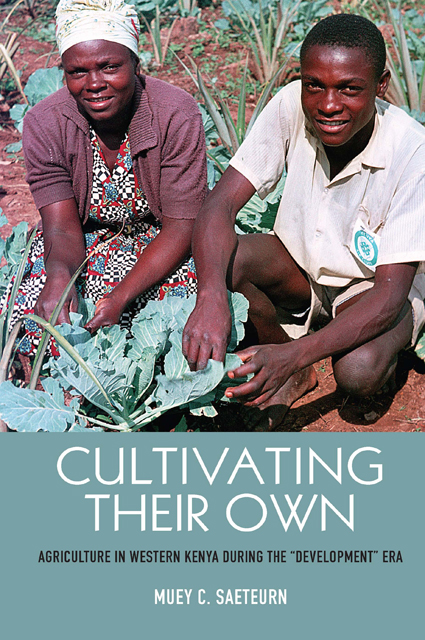Book contents
- Frontmatter
- Dedication
- Contents
- Acknowledgments
- Acronyms and Abbreviations
- Maps
- Introduction
- 1 The Role of Agriculture in Kenya’s Political Economy in the Era of Transition and Independence
- 2 Western Kenya’s Region, People, and the Origins of Population Density
- 3 Chavakali Secondary School: A Place of Learning and Farming
- 4 “Doing Their Part”: 4-K Farmers’ Clubs
- 5 Friends and Acres: The Friends Africa Mission Stewardship Program
- 6 “Home is Home”: The Lugari Settlement Scheme and Maragoliland
- Conclusion: Agricultural Production—The New (Old) Sexy
- Appendix: Interviewee Information
- Notes
- Bibliography
- Index
2 - Western Kenya’s Region, People, and the Origins of Population Density
Published online by Cambridge University Press: 18 January 2023
- Frontmatter
- Dedication
- Contents
- Acknowledgments
- Acronyms and Abbreviations
- Maps
- Introduction
- 1 The Role of Agriculture in Kenya’s Political Economy in the Era of Transition and Independence
- 2 Western Kenya’s Region, People, and the Origins of Population Density
- 3 Chavakali Secondary School: A Place of Learning and Farming
- 4 “Doing Their Part”: 4-K Farmers’ Clubs
- 5 Friends and Acres: The Friends Africa Mission Stewardship Program
- 6 “Home is Home”: The Lugari Settlement Scheme and Maragoliland
- Conclusion: Agricultural Production—The New (Old) Sexy
- Appendix: Interviewee Information
- Notes
- Bibliography
- Index
Summary
Western Kenya’s Historical Boundaries
Maragoliland is a ninety-five square mile region northwest of Lake Victoria. The territory is located in western Kenya, which has undergone significant administrative changes and boundary shifts over the past century. The British government initially laid claim to this part of Kenya in 1894 when it established the Uganda Protectorate, because the area was largely part of eastern Uganda. By 1902, however, it had become part of the East African Protectorate, which subsequently became the Kenya colony in 1920. The transfer of this region occurred due to the completion of the Uganda railway, which reached present-day Kisumu in 1902, thereby opening the region’s economy to outsiders.
Throughout the colonial era, officials referred to the western Kenya region as Kavirondo or Nyanza Province, dividing it into four districts: Central Nyanza, North Nyanza, South Nyanza, and Kericho. While “nyanza” is the Bantu word for “lake,” referring to Lake Victoria, the definition for Kavirondo meant the place of guns. To the colonial state, the western Kenya area remained North Nyanza or North Kavirondo Province until the early 1960s. The Province split into two separate administrative regions during Kenya’s decolonization process: Nyanza and Western provinces. Kericho, formally a district in the Nyanza Province, was transferred to the Rift Valley region. These provincial and district alterations occurred as a result of the Regional Boundaries Commission.
Following the second Lancaster House talks in February 1962, the Secretary of State for the Colonies appointed an independent commission chaired by Stafford Foster-Sutton to reconfigure Kenya’s provincial boundaries to accompany the implementation of the complicated majimbo (regionalism) constitution, which as shown in chapter 1 above was a semi-federalist constitution that divided the country into six regional assemblies with a central government in Nairobi. The return to the provincial system after independence meant that the Western Region became known as the Western Province by the middle of the 1960s. This province consisted of three districts: Kakamega, Bungoma, and Busia. The former district of North Nyanza was folded into Kakamega, which became the provincial headquarters. Kakamega district in 1964 consisted of four administrative divisions: Vihiga, Central, Lurambi, and Mumias.
- Type
- Chapter
- Information
- Cultivating their OwnAgriculture in Western Kenya during the 'Development' Era, pp. 41 - 55Publisher: Boydell & BrewerPrint publication year: 2020



